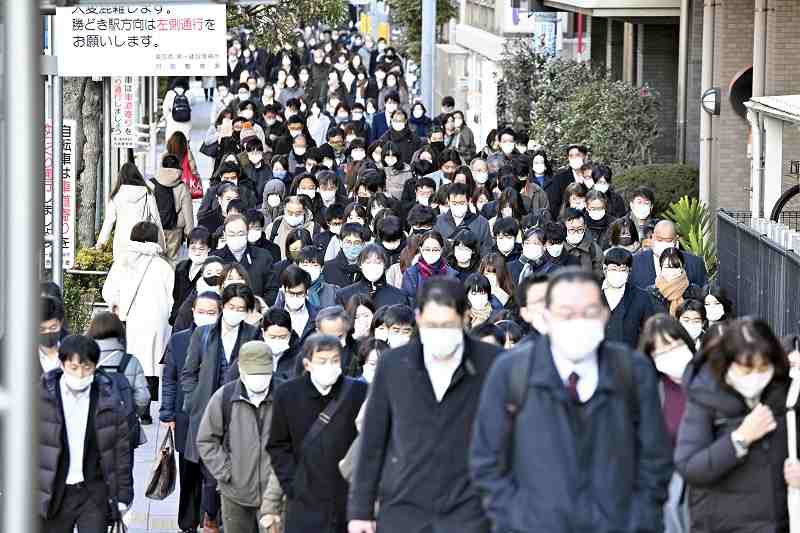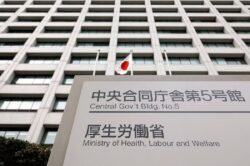
People are seen heading to work wearing masks in Tokyo in January 2022.
18:52 JST, November 29, 2022
Japan recorded the world’s highest weekly number of new coronavirus infections for three consecutive weeks from Oct. 31 to Nov. 20, the World Health Organization has reported. This marks a revival of a surge that kept Japan at No.1 in the world for new weekly cases for ten weeks straight during the so-called seventh wave this past summer, and means Japan has claimed the world’s top spot for 13 of the last 18 weeks, over the roughly four months from late July to mid-November.
Despite a national tendency to react strongly to global case rankings, being by turns proud or disappointed depending on the numbers, this “worst in the world” ranking saw minimal domestic reporting. So far, Japan’s major newspapers, including The Yomiuri Shimbun, have not reported on the subject even in their ‘news in brief’ sections, except in a story from a wire service.
Although the wire story on Nov. 10 said “[Japan] was No. 1 for cases but there were relatively few deaths,” Japan ranked second for the number of deaths from COVID-19 the following week. The report seems to suggest a desire among some to believe that Japan cannot be the worst in the world.
What caused the surge?
Right after Japan recorded the world’s highest number of cases for the first time in late July, a well-known doctor appeared on a TV show as a commentator, saying: “Most other countries have already abandoned COVID-19 tests and relevant measures. As Japan has diligently continued testing, its number of positive cases has claimed the world’s top spot.”
Many viewers likely assumed what he said was true. However, reduced testing in other countries cannot account for Japan’s rise to the top.
To be sure, testing in countries such as the U.K., France and Israel has steeply declined since the spring. The WHO’s weekly epidemiological report continuously warns that “the number of reported COVID-19 cases is an underestimate of the actual number of cases in the population.” However, the number of tests in Japan was originally less than in the above countries. Japan’s cases curve doesn’t always match trends in other countries or for the world as a whole, with its caseload having rapidly increased. The pace in Japan is not a relative phenomenon influenced by other countries’ reduced testing but an independent phenomenon.
In the spring, record-breaking COVID surges driven by the omicron variant hit Hong Kong, South Korea and other regions and countries in quick succession. As such parts of East Asia had worked harder to prevent COVID-19 infection, fewer positive cases in relative terms throughout the pandemic, except during the outbreak in Wuhan at the beginning, meant that cumulative cases were lower than in the U.S. and European countries.
As a result, the number of people who had acquired natural immunity after infection was lower than in Western countries, leading to a sudden surge two years after the pandemic’s start, according to some studies on the East Asian surges in the spring. If this hypothesis is right, Japan’s surge in the summer can be interpreted as the same phenomenon experienced by other East Asian countries, differing only by a delay of one season. Even now, as China and South Korea are experiencing rising caseloads. Japan’s caseload for November can be seen as following a similar trend.
Life expectancy, excess mortality
The average fatality rate for COVID-19 is falling globally. However, as the caseload increases, so too does the number of fatalities. For a total of eight weeks over the past four months, Japan’s fatalities have ranked second in the world.
Due to the pandemic, average life expectancy in Japan dropped for both men and women in 2021, down for the first time since 2011, the year of the Great East Japan Earthquake. Average weekly fatalities for the most recent four months stand at about 900, ranging over that time between several hundred and on the high end more than 2,000. Over 10,000 people are estimated to have died from COVID-19 in this period. The present situation suggests that average life expectancy this year will similarly fall at least below the 2020 level, for a possible second consecutive year of decline.
A 2020 report by the WHO requested countries “minimize the potential direct and indirect impact of COVID-19 on life expectancy, due to excess mortality.”
That is to say, the objective of COVID-19 measures is to maintain life expectancy numbers as much as possible, and Japan’s decline in life expectancy due to excess mortality ultimately means policy and public health measures have failed to defeat the health threat. Of course, life expectancies in other countries had already declined in 2020 statistics. But Japan is not an exceptional country, and its people do not seem to possess a special ability to resist COVID-19, as some prominent scientists suggested hypothetically at the relatively early stage of the pandemic. Nevertheless, it does seem that some people still believe or want to believe in Japan’s exceptionalism.
The real problem
The media does not report proactively on what people have already lost interest in. Is this, perhaps, what psychologists call “normalcy bias”? The term is defined as a cognitive bias that causes people to disbelieve or reject warnings of natural disaster or other threats without any evidence. In daily life, this bias helps to reduce anxiety and worry, but when an emergency happens, it sometimes restricts our ability to take needed action. In the Great East Japan Earthquake and subsequent tsunami in 2011, many people are thought to have lost their lives because they assumed they were safe, the result of a normalcy bias.
Japanese people are proud of having the world’s highest rate of mask wearing, the country’s high level of hygiene and their general diligence amid the pandemic. However, focusing on such aspects may make us too optimistic to perceive emerging threats. Health threats will emerge regardless of our beliefs and self-confidence.
Now is the time to remember lessons from the past disasters that have struck this country, where earthquakes and tsunami are a common experience. We had best act carefully and listen when there are repeated warnings, even if it ends in unnecessary anxiety, as when an alert is issued for a linear rainband, whose forecast is often off. That is the very factor we have specifically had, isn’t it?
"Society" POPULAR ARTICLE
-

M4.9 Earthquake Hits Tokyo, Neighboring Prefectures
-

Israeli Tourists Refused Accommodation at Hotel in Japan’s Nagano Pref., Prompting Protest by Israeli Embassy and Probe by Prefecture
-

M7.5 Earthquake Hits Northern Japan; Tsunami Waves Observed in Hokkaido, Aomori and Iwate Prefectures
-

Tsukiji Market Urges Tourists to Avoid Visiting in Year-End
-

M5.7 Earthquake Hits Japan’s Kumamoto Pref., Measuring Upper 5 Intensity, No Tsunami Expected
JN ACCESS RANKING
-

Tokyo Economic Security Forum to Hold Inaugural Meeting Amid Tense Global Environment
-

Keidanren Chairman Yoshinobu Tsutsui Visits Kashiwazaki-Kariwa Nuclear Power Plant; Inspects New Emergency Safety System
-

Imports of Rare Earths from China Facing Delays, May Be Caused by Deterioration of Japan-China Relations
-

University of Tokyo Professor Discusses Japanese Economic Security in Interview Ahead of Forum
-

Japan Pulls out of Vietnam Nuclear Project, Complicating Hanoi’s Power Plans
























